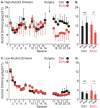Adolescent Alcohol Drinking Renders Adult Drinking BLA-Dependent: BLA Hyper-Activity as Contributor to Comorbid Alcohol Use Disorder and Anxiety Disorders
- PMID: 29135933
- PMCID: PMC5704158
- DOI: 10.3390/brainsci7110151
Adolescent Alcohol Drinking Renders Adult Drinking BLA-Dependent: BLA Hyper-Activity as Contributor to Comorbid Alcohol Use Disorder and Anxiety Disorders
Abstract
Adolescent alcohol drinking increases the risk for alcohol-use disorder in adulthood. Yet, the changes in adult neural function resulting from adolescent alcohol drinking remain poorly understood. We hypothesized that adolescent alcohol drinking alters basolateral amygdala (BLA) function, making alcohol drinking BLA-dependent in adulthood. Male, Long Evans rats were given voluntary, intermittent access to alcohol (20% ethanol) or a bitter, isocaloric control solution, across adolescence. Half of the rats in each group received neurotoxic BLA lesions. In adulthood, all rats were given voluntary, intermittent access to alcohol. BLA lesions reduced adult alcohol drinking in rats receiving adolescent access to alcohol, but not in rats receiving adolescent access to the control solution. The effect of the BLA lesion was most apparent in high alcohol drinking adolescent rats. The BLA is essential for fear learning and is hyper-active in anxiety disorders. The results are consistent with adolescent heavy alcohol drinking inducing BLA hyper-activity, providing a neural mechanism for comorbid alcohol use disorder and anxiety disorders.
Keywords: amygdala; chronic; ethanol; fear; intermittent; rat; voluntary.
Conflict of interest statement
The authors declare no conflict of interest.
Figures






Similar articles
-
Adolescent alcohol exposure modifies adult anxiety-like behavior and amygdala sensitivity to alcohol in rats: Increased c-Fos activity and sex-dependent microRNA-182 expression.Pharmacol Biochem Behav. 2024 May;238:173741. doi: 10.1016/j.pbb.2024.173741. Epub 2024 Mar 2. Pharmacol Biochem Behav. 2024. PMID: 38437922
-
Alcohol gains access to appetitive learning through adolescent heavy drinking.Behav Neurosci. 2015 Aug;129(4):371-9. doi: 10.1037/bne0000075. Epub 2015 Jun 8. Behav Neurosci. 2015. PMID: 26052793 Free PMC article.
-
Network States in the Basolateral Amygdala Predicts Voluntary Alcohol Consumption.bioRxiv [Preprint]. 2024 Mar 3:2023.06.21.545962. doi: 10.1101/2023.06.21.545962. bioRxiv. 2024. PMID: 38464012 Free PMC article. Preprint.
-
Potential role of adolescent alcohol exposure-induced amygdaloid histone modifications in anxiety and alcohol intake during adulthood.Neurobiol Dis. 2015 Oct;82:607-619. doi: 10.1016/j.nbd.2015.03.019. Epub 2015 Mar 24. Neurobiol Dis. 2015. PMID: 25814047 Free PMC article.
-
Teenage drinking and adult neuropsychiatric disorders: An epigenetic connection.Sci Adv. 2022 May 6;8(18):eabq5934. doi: 10.1126/sciadv.abq5934. Epub 2022 May 4. Sci Adv. 2022. PMID: 35507664 Free PMC article. Review.
Cited by
-
Prevalence of Psychiatric Disorders among Children and Adolescents: A Study from Khuzestan.Iran J Child Neurol. 2022 Summer;16(3):95-107. doi: 10.22037/ijcn.v15i4.27319. Epub 2022 Jul 16. Iran J Child Neurol. 2022. PMID: 36204445 Free PMC article.
-
Moderate adolescent chronic intermittent ethanol exposure sex-dependently disrupts synaptic transmission and kappa opioid receptor function in the basolateral amygdala of adult rats.Neuropharmacology. 2021 May 1;188:108512. doi: 10.1016/j.neuropharm.2021.108512. Epub 2021 Mar 2. Neuropharmacology. 2021. PMID: 33667523 Free PMC article.
-
Synaptic Plasticity in the Bed Nucleus of the Stria Terminalis: Underlying Mechanisms and Potential Ramifications for Reinstatement of Drug- and Alcohol-Seeking Behaviors.ACS Chem Neurosci. 2018 Sep 19;9(9):2173-2187. doi: 10.1021/acschemneuro.8b00169. Epub 2018 Jun 13. ACS Chem Neurosci. 2018. PMID: 29851347 Free PMC article.
-
Prevalence and Correlates of Psychiatric Disorders in a National Survey of Iranian Children and Adolescents.Iran J Psychiatry. 2019 Jan;14(1):1-15. Iran J Psychiatry. 2019. PMID: 31114613 Free PMC article.
-
Constitutive Genetic Deletion of Hcn1 Increases Alcohol Preference during Adolescence.Brain Sci. 2020 Oct 22;10(11):763. doi: 10.3390/brainsci10110763. Brain Sci. 2020. PMID: 33105624 Free PMC article.
References
-
- Substance Abuse and Mental Health Services Administration . In: Results from the 2013 National Survey on Drug Use and Health: Summary of National Findings. Rockville M.D., editor. Department of Health and Human Services; Washington, DC, USA: 2014. (Volume NSDUH Series H-48).
Grants and funding
LinkOut - more resources
Full Text Sources
Other Literature Sources

